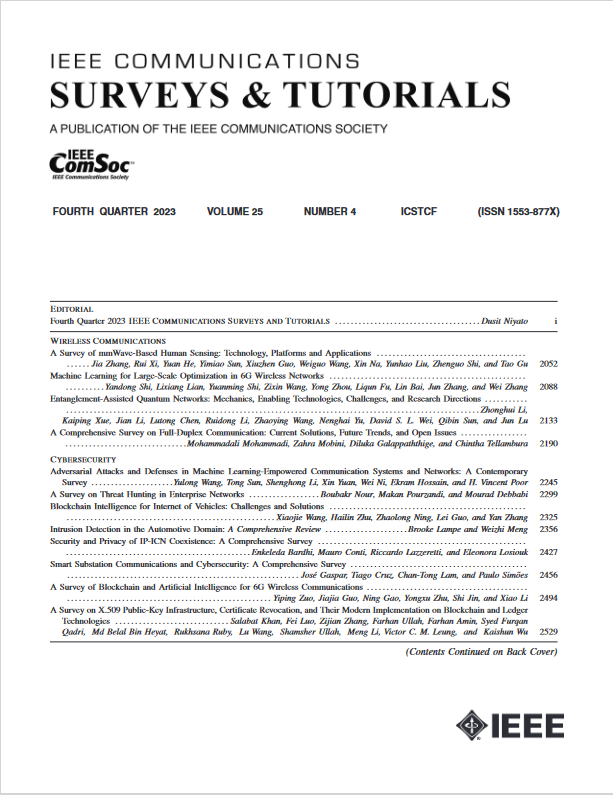关于超宽带波雷达的全面概述:应用、标准、信号处理技术、数据集、无线电芯片、趋势和未来研究方向
IF 34.4
1区 计算机科学
Q1 COMPUTER SCIENCE, INFORMATION SYSTEMS
引用次数: 0
摘要
由于其大带宽,相对较低的成本和强大的性能,超宽带(UWB)无线电芯片可用于各种各样的应用,包括定位,通信和雷达。本文对超宽带雷达技术的最新进展进行了详尽的综述。本调查的目的是提供超宽带雷达的技术基础和新兴趋势的全面观点。我们的分析分为多个部分。首先,从技术和标准化的角度探讨了超宽带雷达技术的基本概念。其次,我们研究了最相关的超宽带应用和用例,如无设备定位、活动识别、存在检测和生命体征监测,讨论了每次的带宽需求、处理技术、算法、最新发展、相关的示例论文和趋势。接下来,我们将引导读者了解相关数据集和可用的无线电芯片组。最后,我们讨论了当前的挑战和潜在的未来研究途径。因此,这篇综述论文旨在成为研究人员在过去十年中绘制超宽带雷达技术进程的基础参考。本文章由计算机程序翻译,如有差异,请以英文原文为准。
A Comprehensive Overview on UWB Radar: Applications, Standards, Signal Processing Techniques, Datasets, Radio Chips, Trends and Future Research Directions
Due to their large bandwidth, relatively low cost, and robust performance, Ultra-Wideband (UWB) radio chips can be used for a wide variety of applications, including localization, communication, and radar. This article offers an exhaustive survey of recent progress in UWB radar technology. The goal of this survey is to provide a comprehensive view of the technical fundamentals and emerging trends in UWB radar. Our analysis is categorized into multiple parts. Firstly, we explore the fundamental concepts of UWB radar technology from a technology and standardization point of view. Secondly, we examine the most relevant UWB applications and use cases, such as device-free localization, activity recognition, presence detection, and vital sign monitoring, discussing each time the bandwidth requirements, processing techniques, algorithms, latest developments, relevant example papers, and trends. Next, we steer readers toward relevant datasets and available radio chipsets. Finally, we discuss ongoing challenges and potential future research avenues. As such, this overview paper is designed to be a cornerstone reference for researchers charting the course of UWB radar technology over the last decade.
求助全文
通过发布文献求助,成功后即可免费获取论文全文。
去求助
来源期刊

IEEE Communications Surveys and Tutorials
COMPUTER SCIENCE, INFORMATION SYSTEMS-TELECOMMUNICATIONS
CiteScore
80.20
自引率
2.50%
发文量
84
审稿时长
6 months
期刊介绍:
IEEE Communications Surveys & Tutorials is an online journal published by the IEEE Communications Society for tutorials and surveys covering all aspects of the communications field. Telecommunications technology is progressing at a rapid pace, and the IEEE Communications Society is committed to providing researchers and other professionals the information and tools to stay abreast. IEEE Communications Surveys and Tutorials focuses on integrating and adding understanding to the existing literature on communications, putting results in context. Whether searching for in-depth information about a familiar area or an introduction into a new area, IEEE Communications Surveys & Tutorials aims to be the premier source of peer-reviewed, comprehensive tutorials and surveys, and pointers to further sources. IEEE Communications Surveys & Tutorials publishes only articles exclusively written for IEEE Communications Surveys & Tutorials and go through a rigorous review process before their publication in the quarterly issues.
A tutorial article in the IEEE Communications Surveys & Tutorials should be designed to help the reader to become familiar with and learn something specific about a chosen topic. In contrast, the term survey, as applied here, is defined to mean a survey of the literature. A survey article in IEEE Communications Surveys & Tutorials should provide a comprehensive review of developments in a selected area, covering its development from its inception to its current state and beyond, and illustrating its development through liberal citations from the literature. Both tutorials and surveys should be tutorial in nature and should be written in a style comprehensible to readers outside the specialty of the article.
 求助内容:
求助内容: 应助结果提醒方式:
应助结果提醒方式:


